Mastering the Art of Cleaning Cast Iron Pans

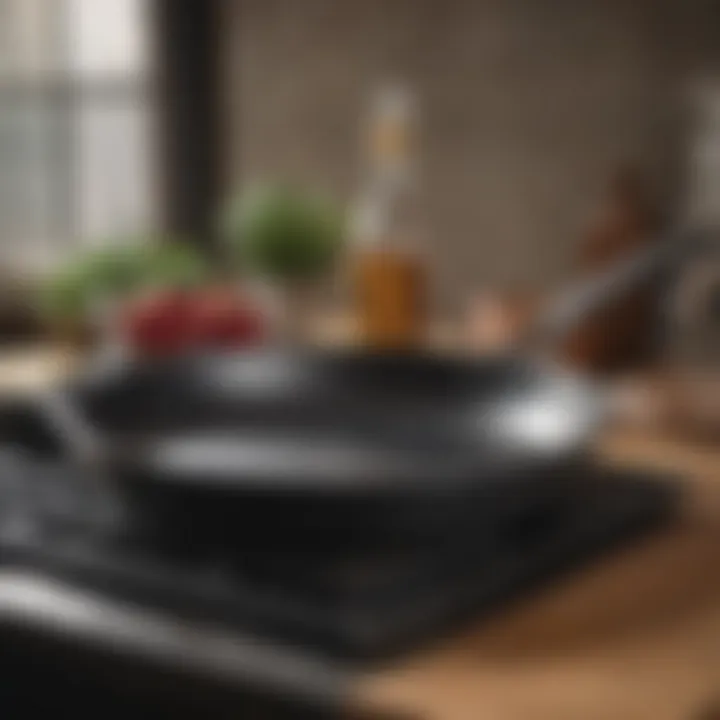
Intro
Cleaning seasoned cast iron pans may seem like a modest task, but it holds immense significance in the realm of culinary arts. These pans are not just cooking tools; they are an extension of one’s culinary identity, often passed down through generations. Proper cleaning and maintenance not only extend the lifespan of these pans but also impact the flavor and quality of the food prepared in them.
In this guide, we’ll delve into effective cleaning techniques, discuss the importance of maintaining seasoning, and look into practices that help preserve the integrity of your cast iron. The information presented will serve to enlighten both novice cooks and seasoned chefs alike, enabling them to harness the full potential of their cast iron cookware.
The Essence of Seasoning
To truly appreciate the cleaning of cast iron, one must understand seasoning. Seasoning is a layer of polymerized fat that bonds to the cast iron, creating a natural non-stick surface. This process also protects the pan from rusting. However, this delicate layer can be compromised if not cleaned appropriately.
- Key Benefits of Proper Seasoning:
- Enhances non-stick capability
- Supports even heat distribution
- Imparts flavor to dishes over time
Recognizing the significance of maintaining this seasoning leads to a more enjoyable cooking experience. When food residue accumulates, it can result in unpleasant flavors and potentially ruin a dish that was otherwise crafted with care. Understanding the nuances of cleaning is key to preserving these properties.
"A well-maintained cast iron pan is like a reliable friend in the kitchen. It stands by you through thick and thin, enhancing the flavors of every meal."
This guide aims to equip you with comprehensive knowledge about cleaning your seasoned cast iron pans, ensuring that they continue to perform at their best. Let’s explore the various methods of cleaning, preventative measures, and much more, so you can keep your trusty cookware in top shape.
Prologue to Cast Iron Cookware
Cast iron cookware has stood the test of time, cherished by both amateur cooks and culinary experts alike. It's known for its remarkable heat retention and distribution properties, making it ideal for a variety of cooking methods. The right pieces can improve with age, developing a natural, non-stick surface through proper seasoning. This section will unfold the many facets of cast iron cookware, emphasizing its significance not only in kitchens but also in the art of cooking itself.
Understanding the Appeal of Cast Iron
What makes cast iron so beloved? First off, it’s durability. A well-taken-care-of cast iron pan can last generations. These pans can withstand high heat and they are versatile enough to transition seamlessly from stovetop to oven. Furthermore, they often become an ancestral heirloom, a touchstone for family traditions and recipes passed down through generations.
Also, cooking with cast iron can enhance flavor. As these pans age, they develop a natural seasoning that can contribute to taste. When you cook with them regularly, they build up a kind of reputation, creating layers of flavor that modern cooking implements just can’t replicate.
Moreover, there's something inherently satisfying about using a piece of cookware that requires a bit of care— a task not everyone might enjoy, but for enthusiasts, it’s a passion. Every time you pull out a cast iron skillet, you’re engaging with history. It’s not just cooking; it’s connecting to those who cooked before you.
The Role of Seasoning in Cooking Performance
Seasoning is not merely a buzzword when discussing cast iron; it’s a fundamental aspect that directly impacts cooking performance. When we talk about seasoning, we refer to the layer of polymerized oil that's built up over time through careful use and maintenance. This layer not only prevents food from sticking but also protects the cast iron from rust.
Why is this crucial? Essentially, a well-seasoned pan can perform at its best, offering that coveted non-stick experience. When the oil is heated, it undergoes a transformation that creates a smooth surface. It’s akin to a culinary paramedic, rescuing your food from adhering stubbornly to the pan.
Utilizing a properly seasoned cast iron can make a world of difference when searing meats or sautéing vegetables. The size of the pan can easily handle the high temperature, ensuring a beautifully seared exterior without compromising the tenderness of what's inside.
In addition to its practical benefits, seasoning also enhances the food's taste. All those past meals, each layered upon one another, bring out unique flavors that create an intricate ballet on the palate.
In essence, cast iron pans are more than just tools. They represent a deep culinary tradition that marries modern cooking techniques with age-old practices. Understanding their appeal, along with the paramount role of seasoning, sets the stage for a more profound appreciation—and knowledgeably caring for these invaluable kitchen companions.
Importance of Proper Cleaning Techniques
Cleaning cast iron pans correctly is not merely a chore; it's a pivotal aspect of maintaining their performance and longevity. A well-maintained cast iron skillet can last generations, but improper care might lead to unnecessary wear and tear. It's akin to regularly servicing a classic car; neglect it, and it deteriorates, losing its value and functionality. In the case of cast iron, proper cleaning techniques ensure that those prized cooking surfaces remain in top-notch condition.
For instance, the seasoning on a pan acts much like a protective lacquer. This layer, made from polymers formed by the oils during cooking, provides a natural non-stick surface and contributes to enhanced flavors in your dishes. Clean your pan too aggressively or incorrectly, and you'll risk damaging this vital seasoning layer. Knowing how to clean, what tools to use, and when to refrain from scrubbing can make all the difference in maintaining the quality of your cast iron cookware.
Effects of Residue on Flavor and Texture
Residue on your cast iron skillet isn’t just an eyesore. It can have profound impacts on the flavor and texture of the dishes you prepare.
When food is cooked in a pan that hasn't been cleaned properly, leftover bits can become charred and slightly bitter, which then leaches into the next meal you make. Imagine a fine cornbread, only to have it carry the taste of an old steak. That's not what anyone wants at their dinner table. Moreover, residual food can interfere with heat distribution, causing uneven cooking—resulting in a chewy, uneven texture instead of the desired crispy sear.
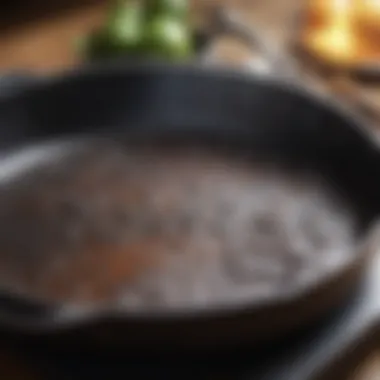
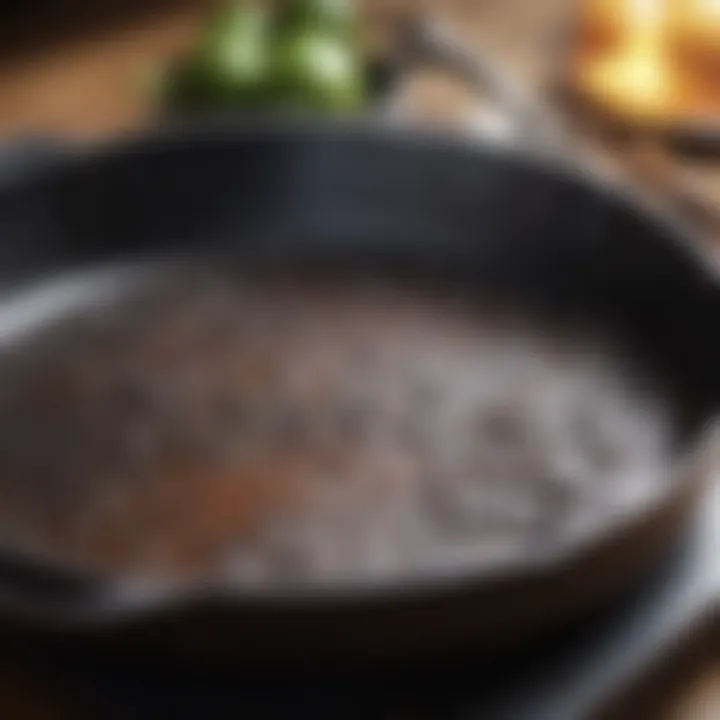
Therefore, cleaning your cast iron pan while being mindful of any residue is crucial. The goal is to ensure that each meal is as flavorful as intended, allowing the rich, complex tastes to shine through.
Preserving the Seasoning Layer
The seasoning layer on a cast iron pan isn’t just for decoration; it's the heart and soul of the cooking experience. It’s crucial to preserve this layer to keep your cookware effective.
When cleaning, avoid abrasive materials that can strip away this protective coating. Instead, simple methods like hot water and gentle scrubbing can keep the seasoning intact. If you've neglected your skillet for a while, and that layer appears compromised, consider a light re-seasoning. This involves applying oil and heating the pan until smoke wafts up—essentially reminding the cast iron how to shine again.
The seasoning also builds over time, enhancing the pan's nonstick properties and providing a depth of flavor unique to cast iron. Just think of it like adding patina to wood furniture—it gains character while serving its purpose.
"The strength of a cast iron pan lies in its seasoned layer, serving both as a cooking surface and a flavor enhancer."
Basic Cleaning Methods
Cleaning seasoned cast iron pans is an art of its own, a delicate balance of care and technique. The way you clean your cookware directly impacts its longevity and cooking performance. Basic cleaning methods form the bedrock of maintaining your pans, ensuring that they stay in tip-top shape for years to come. Often underappreciated, these techniques are essential to preserve the seasoning that gives cast iron its unique cooking properties.
The Use of Hot Water and Scrubbing
When it comes to cleaning, hot water is your best friend. It loosens stubborn food remnants, making the job far easier. You don’t need to be a cleaning whizz to understand the value of simply rinsing your cast iron with hot water immediately after use. This method helps avoid the dreaded food buildup that can lead to flavor loss.
After rinsing, grab a non-metal scrubbing pad or a stiff brush to tackle any leftover bits firmly yet gently. Avoid harsh abrasives like steel wool. Scrubbing too hard can risk damaging the seasoning. Instead, focus on a back-and-forth motion, paying close attention to those spots where food likes to cling. This method not only helps remove residue effectively, it also minimizes the need for additional maintenance down the line.
"Hot water is a cast iron's best ally, easing the battle against stuck food remnants."
Employing Salt as an Abrasive
Salt serves as a wonderful scrub for stubborn spots. It's not just for cooking—it's a stellar cleaning agent in its own right. A handful of kosher salt sprinkled on the pan, combined with a bit of water, can work wonders. The coarse texture acts as an abrasive without being harsh on the cast iron surface.
Just pour the salt into your pan and use a damp cloth or sponge to scrub the area affected. The salt’s grains will help dislodge sticky food bits while preserving your pan’s seasoned finish. Afterward, simply rinse with hot water and dry it thoroughly. This method can become a go-to cleaning technique, particularly for those greasy skillet moments.
Utilizing a Chain Mail Scrubber
The chain mail scrubber is a nifty little tool that’s worth considering. It’s made from interlocking metal rings designed to tackle tough residues while still being gentle on your cast iron. Use it in the same manner you would use a stiff sponge—with a bit of hot water and the pan heated slightly to help remove residue more effectively.
The advantage of the chain mail is its durability; with proper care, it can last for years. Plus, it can reach into those hard-to-clean areas often neglected by standard scrubbing methods. Just remember, after your chains have done their job, rinse your pan under hot water to remove any leftover bits.
Employing these basic methods of cleaning not only enhances your cast iron's performance but also extends its lifespan. With a bit of practice and the right techniques, keeping a seasoned cast iron pan sparkling clean is not just rewarding, it’s an essential part of ensuring every meal cooked in it is nothing short of exceptional.
Advanced Cleaning Techniques
When it comes to maintaining seasoned cast iron pans, knowing how to tackle persistent residue and stubborn buildup is a game changer. Advanced cleaning techniques provide the tools necessary for keeping your cookware in tip-top shape, ensuring that your culinary creations taste their best. These methods go beyond basic cleaning and address specific challenges that can arise over time.
Dealing with Stubborn Buildup
Stubborn buildup on cast iron pans can lead to unwanted flavors or even affect the cooking surface's performance. Let's delve into some effective advanced techniques that can restore the integrity of your seasoned cast iron cookware.
Using Baking Soda
Baking soda is often viewed as a versatile household staple. When it comes to cleaning cast iron, its unique alkaline properties make it a formidable foe against stubborn residues. Baking soda acts as a gentle abrasive, which allows it to scrub away grime without risking damage to the seasoning.
One of the key characteristics of baking soda is its ability to neutralize acids. This helps in dissolving food particles and crusted residues that might be stuck to the pan. Using it is quite simple; make a paste with water and apply it to the affected areas. After letting it sit for a while, scrub it off with a non-metal brush or gentle scrubber.
This process not only cleans but also empowers you to keep your seasoning intact, which is crucial for long-term use. However, while baking soda is effective, it’s important to rinse thoroughly afterward to prevent any odd tastes in your next meal.
Implementing Vinegar Soaks
When layers of grime sit stubbornly on your cast iron pan, a vinegar soak may be the solution you’re looking for. White vinegar, known for its acidity, can effectively break down tough, stuck-on residues. Soaking the pan in a vinegar solution (with equal parts water) can soften the debris, making it easier to remove.
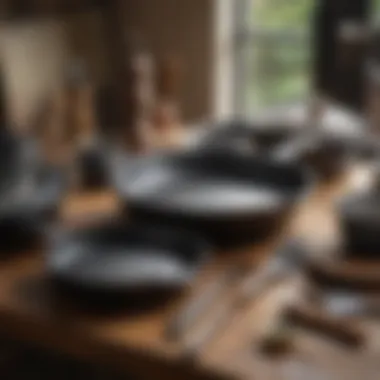
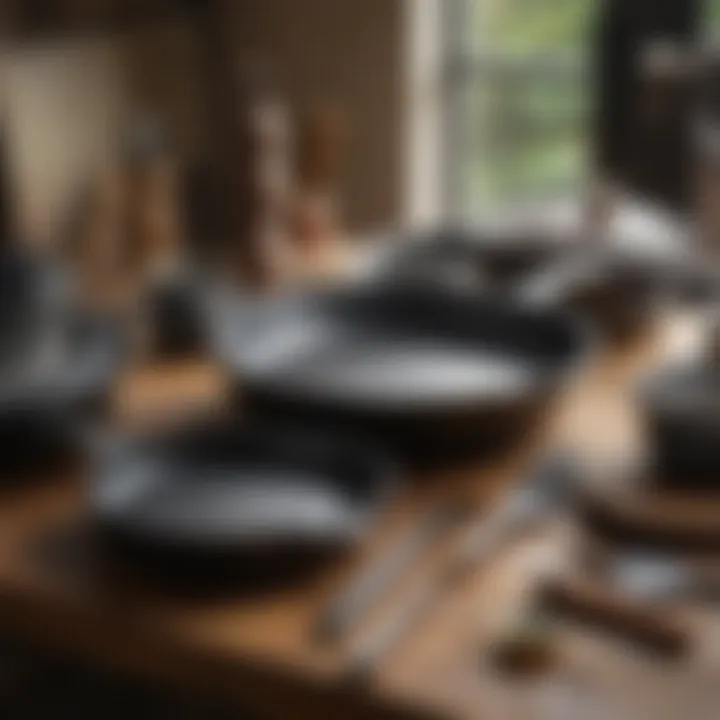
A significant aspect of vinegar soaks is how they quickly get to work on burnt-on food and residue, letting the magic of time do some of the cleaning for you. Dip the pan and leave it to soak for approximately an hour. After that, scrub the surface with a soft sponge to lift away the softened particles. This method is popular because it’s relatively hands-off, requiring minimal effort on your part.
Nevertheless, use caution with vinegar; prolonged exposure can affect the seasoning layer. It is best to limit these soaks to situations where buildup is truly problematic.
Cleaning with Oil
Another advanced technique to consider involves cleaning your cast iron with oil. This might sound counterintuitive, but when done correctly, using oil can help retain and enhance the seasoning on your skillet. After cooking, while the pan is still warm, wipe it down with a paper towel or cloth moistened with a bit of oil. This step removes surface debris and adds a protective layer that can fend off rust.
Careful attention to this cleaning method fosters a synergistic relationship with your pan, as it nurtures the seasoning rather than stripping it away. Using grapeseed or flaxseed oil may be advisable due to their high smoke points, which are excellent for maintaining the integrity of your cookware over time.
Avoiding Common Mistakes
When it comes to cleaning seasoned cast iron pans, many enthusiasts often find themselves navigating a maze of misinformation and bad habits that can diminish the quality and lifespan of their cookware. Understanding and avoiding common mistakes is crucial not only for preserving the pan’s seasoning but also for optimizing its cooking performance. This section addresses misconceptions and offers clarity on best practices, ensuring your cast iron pans remain in top shape, ready for that perfect sear or slow-simmered sauce.
Debunking Misconceptions
Using Soap on Cast Iron
One of the biggest myths floating around in the culinary community is that soap is the enemy of cast iron. Many believe that applying soap to their beloved pans would strip away the carefully built seasoning. This belief often stems from a misunderstanding of modern soaps, which tend to be milder than those from decades ago. In reality, a small amount of soap can effectively clean your pan without much damage to the seasoning layer, particularly if the pan is well-maintained.
The key characteristic of using soap lies in moderation. While it isn’t advisable to scrub your pan down with dish detergent every time, using a gentle soap occasionally can help remove bacteria and stubborn bits of food. It’s like giving your pan a refreshing shower rather than a full-on scrub.
- Advantages:
- Disadvantages:
- A modest amount of soap can effectively sanitize your cookware.
- It might help remove stubborn residues that water alone can’t handle.
- Overusing soap might lead to gradual wear of the seasoning.
A unique feature of soap is that it can help maintain hygiene, which shouldn’t be overlooked. Thus, use soap wisely, sparingly, and only when necessary to keep your pan’s integrity intact.
Over-scrubbing the Pan
Another common pitfall involves scrubbing with too much ferocity. Yes, the goal is to keep your cast iron clean, but over-scrubbing can lead to unintended damage. The allure of a perfectly spotless pan may lead some to scrub away not just residue, but also the seasoning layer that makes cast iron cooking so rewarding.
This practice can often strip your pan of its most essential quality – the non-stick surface developed through seasoning. It’s important to adopt a gentler approach; think of it like tending to a delicate flower instead of a resilient weed.
- Advantages:
- Disadvantages:
- Gentle cleaning preserves the seasoning.
- It keeps the surface intact longer, which enhances the lifespan of the pan.
- Inadequate cleaning might lead to the buildup of food particles or bacteria.
Understanding how to strike the right balance when scrubbing involves being gentle while being mindful of residue. Take care with your cleaning tools, opting for softer sponges or cloths that won’t rough up your pan.
Recognizing When Not to Clean
Knowing when to leave well enough alone is just as important as knowing how to clean. Sometimes, the best maintenance is little to no maintenance at all. If your cast iron pan has only had a light use and is free from significant food buildup, there’s no need for a full scrub down.
- Observation is Key: The seasoned surface is typically resilient. If all you've used the pan for is to sauté a few vegetables and wipe it out with a paper towel afterward, it might be best to simply put it back in storage.
- Assessing Condition: If you’ve cooked something that left only minor residuals, it’s better to avoid the temptation to scrub. The seasoning benefits from the natural oils left behind from cooking, so a light wipe is often all that’s needed.
Recognizing the condition of your pan will save time and also help sustain its surface quality.
"An ounce of prevention is worth a pound of cure" – keeping your cast iron clean requires as much intuition as it does technique.
Routine Maintenance of Seasoned Cast Iron


Caring for seasoned cast iron is much like tending to a cherished garden; it requires regular attention to foster a bountiful harvest. Routine maintenance, therefore, becomes essential for those who wish to reap the full rewards of their cookware. Ignoring this vital aspect can lead to diminished cooking performance or even damage. Consider it a marriage — the bond between you and your cast iron, where nurturing it leads to successful meals and lasting friendships.
Regular Seasoning Checks
Regular checks of your cast iron's seasoning aren't just good practice; they are vital. Much like checking the oil level in your car, you want to ensure everything is running smoothly under the hood. Over time and use, the seasoning layer can wear thin or even develop trouble spots. To keep everything shipshape, it's a good habit to inspect your pan's surface after each use.
- Look for dull spots: A shiny surface gleams like a new penny, signaling well-maintained seasoning. Dull spots indicate that your pan may need attention.
- Feel the texture: Run your hand over the cooking surface. It should feel smooth and slightly oily. If it's rough or grimy, it may require a cleaning.
Not only does checking the seasoning prevent food from sticking, it also keeps those lovely flavors intact. When it’s time to re-season, don't fret; this process isn't daunting! A quick rub with some oil can go a long way in rejuvenating the surface.
Re-seasoning Techniques
So, when do you know it’s time to re-season? If you notice that food sticks more in places than it used to, or if your prized cast iron shows signs of rust, this may be a clue. Fear not, as re-seasoning is simpler than it sounds and can be done in a few straightforward steps.
- Clean the Pan Thoroughly: Start by scrubbing the cast iron with hot water and a stiff brush to remove any stubborn residue.
- Dry Completely: After cleaning, dry the pan thoroughly with a soft cloth to prevent moisture from causing rust.
- Apply Oil: Using a paper towel, apply a thin layer of vegetable oil or flaxseed oil to the entire surface, including the handle and outer part.
- Bake It: Place the pan upside down in an oven preheated to about 450°F (232°C). Put a piece of aluminum foil on the lower rack to catch any drips.
- Cool Down: After an hour, turn off the oven and let the pan cool inside. This step allows the seasoning to set properly.
This re-seasoning method ensures your cast iron remains a reliable companion in the kitchen, preserving its non-stick quality while enhancing its resilience to high-heat cooking environments. Each layer built up serves to improve performance, making your pan just a little better with every application.
Remember: A well-maintained cast iron pan is a worthy investment that pays dividends through elevated cooking experiences, tantalizing flavors, and continued usability across generations.
In this world of fleeting trends, a cast iron pan withstands the test of time. Regular maintenance enhances not just the lifespan of the cookware but your culinary journey, letting you savor every meal as if you've just laid it on the table of an Italian grandma who knows her way around the kitchen.
Storage and Care Considerations
Storing seasoned cast iron pans correctly is a vital part of their overall care. Just as a chef considers their ingredients, so should one consider how they store their cookware. Proper storage not only prevents damage but also ensures that the seasoning remains intact and functional. This section looks at various aspects of storage solutions and specific care tips that contribute to the longevity and cooking performance of cast iron pans.
Optimal Storage Solutions
Finding the right storage method for your seasoned cast iron pans can be as important as the seasoning process itself. Here are a few tips that can make a difference:
- Use a Pan Protector: To prevent scratches, using a pan protector or placing a cloth between stacked pans is a good idea. It’s like giving your pans a soft pillow to rest on!
- Hang Them Up: If you have the space, hanging your cast iron pans is effective. This not only saves cabinet space but also keeps them free from scratches and dust. Plus, it adds a rustic touch to your kitchen.
- Keep Them Dry and Clear: Storing your pans in a dry place is paramount. A cluttered cabinet can lead to unintentional bumps and knocks, compromising the seasoning layer. Make sure to designate specific space for each piece.
"Just like a favored recipe, taking care of your cookware ensures its continued success in the kitchen."
Avoiding Humidity and Moisture
Humidity and moisture can both be the foes of cast iron pans. Not only can they lead to rust, but moisture can also break down the carefully constructed seasoning layer that makes cast iron so special. Here are effective strategies to keep your pans dry:
- Air Out After Cleaning: After cleaning your pan, ensure it is thoroughly dry before storing. Sometimes, just leaving it out for a bit can work magic. Heat it on the stove for a minute to shake off any lingering moisture.
- Use Silica Gel Packs: If you live in a particularly humid area, consider tossing a few silica gel packs in with your pans. They help absorb moisture and create a fresher environment.
- Baking Soda Trick: If your pan does encounter some moisture, a light dusting of baking soda before storing can help absorb excess humidity. It’s like giving your pan a little insurance policy against rust!
By paying attention to how and where you store your cast iron pans, you can extend their life and maintain their performance for years to come. Each of these storage strategies helps to safeguard your investment and ensures your cookware is ready to whip up culinary delights whenever you need it.
The End
Effective cleaning and maintenance of seasoned cast iron pans cannot be overstated. This practice not only preserves the pan’s longevity but also enhances its cooking efficiency. At its core, properly caring for cast iron enables one to achieve that much-desired, non-stick surface through well-maintained seasoning, thus improving overall culinary outcomes.
Understanding the essential points discussed throughout this article offers a practical roadmap for both novice and seasoned cooks. Engaging with these techniques means tackling any residue while being gentle with the seasoning. The benefits extend beyond the mere cleanliness of the pan; they include retaining the rich flavors developed over multiple uses, ensuring that every meal cooked resonates with the essence of home-cooked goodness.
When it comes to precautionary measures, avoiding common pitfalls such as abrasive scrubbing or excessive moisture can save cast iron lovers from premature wear. Maintaining a routine of checks and appropriate storage solutions ultimately holds the key to preserving this valuable cookware.
"With the right care, your cast iron can outlast generations, growing richer in character with every meal."
Recap of Essential Points
- Cleaning Techniques: Commitment to proper methods like hot water scrubbing and the use of salt as an abrasive can greatly reduce residue buildup without harming the seasoning.
- Avoiding Mistakes: Recognizing myths about soap and the need to constantly clean can save your pan from unnecessary damage. Remember: less is often more.
- Maintenance is Key: Routine checks on your seasoning layer bolster the pan’s performance over time, keeping it in peak condition.
- Optimal Storage Practices: Keeping cast iron dry and away from moisture is pivotal in maintaining its functionality and preventing rust.
Final Thoughts on Cast Iron Care
Ultimately, the art of caring for cast iron is an ongoing journey. This enduring cookware stands as a testament to well-loved kitchens and culinary heritage. The lore surrounding cast iron is intertwined with patience and dedication, two qualities crucial for achieving lasting results. When you invest the time and effort into your pans' care, you nurture not just the cookware, but also the meals prepared within them.
In closing, embrace your seasoned cast iron—continue to learn, adapt, and savor the process. The rewards are found not only in delicious meals but also in the shared experiences that come from using these remarkable instruments. With every dish, you contribute to the storied history of cast iron cookware, forging connections that go beyond food.















